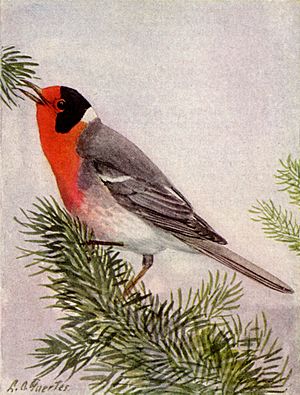Red-faced warbler facts for kids
Quick facts for kids Red-faced warbler |
|
|---|---|
 |
|
| Conservation status | |
| Scientific classification | |
| Genus: |
Cardellina
|
| Species: |
rubrifrons
|
 |
|
|
Breeding range Breeding and wintering range Wintering range |
|
The red-faced warbler (Cardellina rubrifrons) is a small, colorful bird. It belongs to a group of birds called New World warblers. These birds are known for their bright feathers and lively songs.
Contents
What Does a Red-faced Warbler Look Like?
Red-faced warblers are about 14 cm (5+1⁄2 in) long. That's about the size of a sparrow! They have light gray feathers on their back and a white belly. Their most striking feature is their bright red face, neck, and upper chest.
They also have a black cap on their head. The sides of their head are black too. Sometimes, the spot where the black cap meets the gray back can look speckled. These birds have a fun habit of flicking their tail from side to side when they are looking for food.
Where Do Red-faced Warblers Live?
These warblers like to live in mountain forests. They prefer areas with conifer trees and oak trees. You can find them at high elevations, usually between 2,000 to 3,000 m (6,600 to 9,800 ft) above sea level.
During the summer, red-faced warblers live in northern Mexico. They also travel north into the states of Arizona and New Mexico. These areas are sometimes called the Madrean sky islands.
Migration and Winter Homes
When winter comes, many red-faced warblers migrate south. They fly to warmer parts of southern Mexico. They also travel to countries in Central America. These countries include El Salvador, Guatemala, and Honduras.
However, some red-faced warblers stay in Mexico all year. They are permanent residents in the central and southern mountains of western Mexico. This mountain range is known as the Sierra Madre Occidental.
Life Cycle and Nesting
Red-faced warblers build their nests on the forest floor. The nest is shaped like a small cup. They make it from leaves, grass, and pine needles. They hide their nests very well! You might find a nest buried in the ground. It could also be hidden under a small bush, a fallen log, or a rock.
The female warbler lays 3 to 5 eggs. The eggs are white with brown spots. Both parents help care for the eggs and the baby birds. The eggs hatch in about 12 days. The baby birds stay in the nest for another 12 days before they are ready to fly.
See also
 In Spanish: Reinita carirroja para niños
In Spanish: Reinita carirroja para niños



